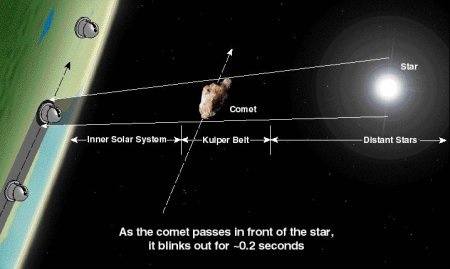The transit method — observing a distant planet as it moves in front of its star as seen from Earth — is a prime tool for exoplanet detection. But transits are hardly limited to planets around their primaries. The Taiwanese-American Occultation Survey (TAOS) is demonstration of that, an attempt to find tiny Kuiper Belt objects (KBOs) in the range between 0.5 and 28 kilometers. As you would imagine, at a distance like this such objects cannot be seen directly, but an occultation — the dimming of a star when one of the KBOs passes in front of it — should be apparent. The image below shows the method applied to a cometary nucleus.

Image: Looking for dimmed starlight — the basic method at work in the TAOS survey. The experiment follows 3000 stars five times per second in its search. Credit: TAOS.
TAOS works with small, wide-field robotic telescopes on peaks near the Yu-Shan (Jade Mountain) National Park in Taiwan. The current results represent 200 hours of collected data using these instruments. And thus far TAOS has come up blank — no occultations. Perhaps the outer Solar System is not as packed with material as we had believed, an indication that smaller bodies have already merged to form the larger objects like Pluto/Charon, Eris, Haumea and their numerous cousins. Collisions may have ground smaller KBOs to a size we cannot observe, even with the equipment involved in the TAOS survey, a potential insight into the history of planetary formation in our Solar System.
The paper on this work explains the mechanisms involved in the Kuiper Belt:
The size distribution of Kuiper Belt Objects (KBOs) is believed to reflect a history of agglomeration during the planetary formation epoch, when relative velocities between particles were low and collisions typically resulted in particles sticking together, followed by destructive collisions when the relative velocities were increased by dynamical processes after the giant planets formed… The slope of the distribution function for larger objects reflects the early phase of agglomeration, while the shallower distribution for smaller objects reflects a subsequent phase of destructive collisions. The location of the break moves to larger sizes with time, while the distribution for smaller objects is expected to evolve towards a steady state collisional cascade…
Given that some theories suggest a crowded Kuiper Belt, getting firm parameters on its density will be helpful. What we have thus far is that the upper size range of Kuiper Belt objects is well represented, with more than sixty bodies with a radius of over 100 kilometers having been detected. And with the help of TAOS, we now have the strongest data yet on the paucity of smaller KBOs in the range the survey is equipped to study. The work at TAOS continues, with a fourth telescope scheduled for deployment in the near future.
